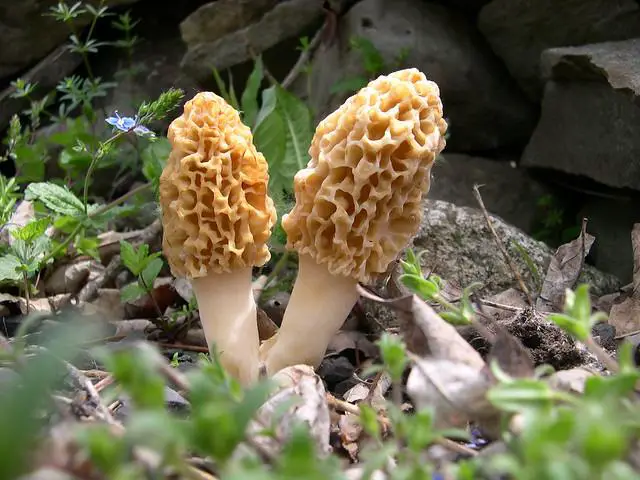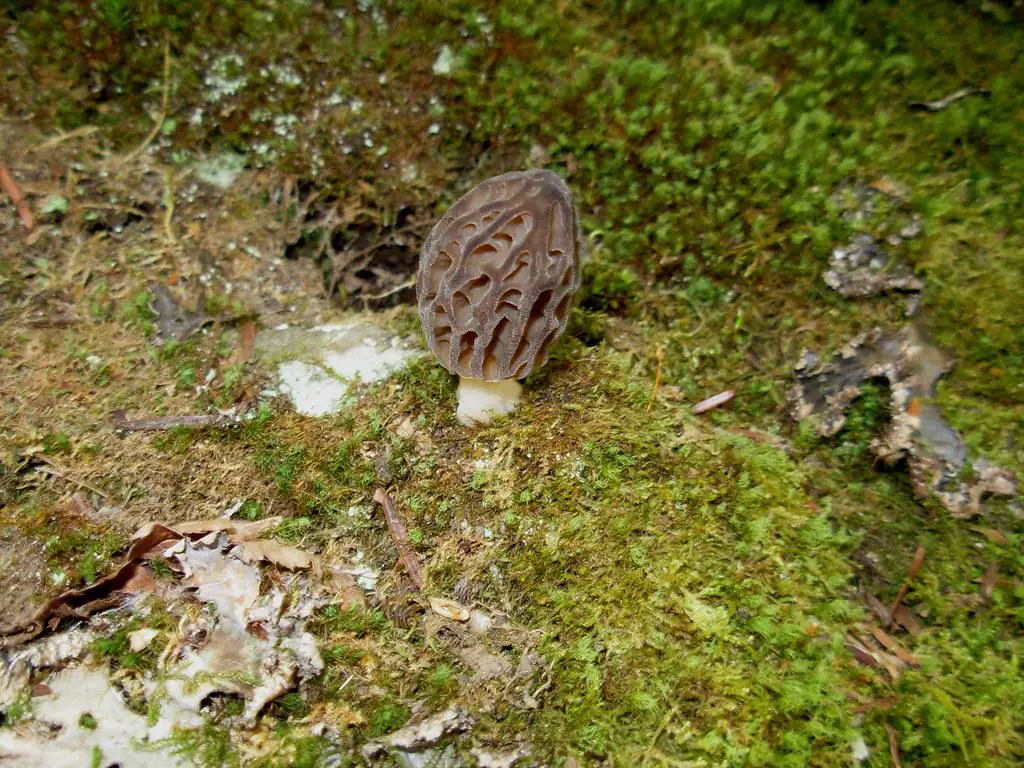
Identification & Safety
True morels stand out from their woodland companions through their unique, honeycomb-like exterior. This spongy appearance is not just their trademark in the kitchen but also your biggest clue when hunting. False morels sport a wrinkled, brain-like cap — fooling the untrained eye but posing significant risks if consumed.
True morels' caps are intimately attached directly to the stem, leaving no room for ambiguity. False morels' caps are often loosely connected or even dangling, giving them a floppier look. Morels offer a cozy interior that's completely hollow — slicing one open reveals it front to back. The look-alikes bear filled or chambered insides, a telltale sign you've crossed paths with the wrong mushroom.
Navigating the forest floor demands more than just a keen eye; it necessitates wisdom. Despite morels and their doppelgängers sharing a springtime awakening, the environments they prefer can offer clues. True morels favor areas treated by fire or those undergoing logging.
Safety while mushroom hunting cannot be overstated. Even seasoned foragers face risks; thus, adopting the "When in doubt, throw it out" motto might just be your best bet. Look upon each find with scrutiny, and perhaps think of it as a rite of passage — true foragers know that patience and exactitude lead to the safest and most rewarding harvests.
In essence, distinguishing between true and false morels comes down to keen observation and an unwavering commitment to safety. With every foray into the woods, it's not just about the thrill of the hunt but ensuring the bounty brought home is not only abundant but safe for the table. No culinary delight is worth a foray into danger. Stay safe, stay curious, and let every mushroom you pick be a testament to both your passion for the natural world and your respect for its complexities.
Foraging Techniques
Venturing into the realm of morel foraging marries the anticipation of a treasure hunt with the profound reverence for nature's cycles and secrets. Morels silently summon those with an understanding of the interconnectedness of forests, veiling their presence among the leaf litter and under the protective shadows of their arboreal allies.
The forests whisper ancient secrets to those patient enough to listen; among them, the key to uncovering morels lurks beneath the boughs of certain trees and the nuances of seasonal change. Morels possess an intricate symbiosis with hardwood forests, particularly favoring the company of elm, ash, and oak trees. What better place to start your foraging journey than by these arboreal sanctuaries, where dead or dying trees generously foster conditions ripe for morel emergence? Here lies the subtle art of understanding ecosystems, realizing that morels are echoes of the forests' intricate narratives.
For our part in this delicate environmental ballet, sustainable harvesting techniques are paramount. Drawing upon the wisdom of those who tread these paths before us, it becomes evident that a mesh bag is not just a tool, but a vessel for ensuring the continuity of morel stories across generations. As we gently coax these fungal jewels from their earthen hideaways, pinching them at their base to preserve their root systems, our bags lightly jostle with each step, liberating countless spores back into the wild.
Such practices transcend mere foraging; they encase a promise to future morel enthusiasts and sustain an unspoken pact with the forest itself. The ideal temperatures – a steady air warmth above 60 degrees combined with soil temperatures lingering between 45 and 50 degrees – signal the advent of morel season and a reminder of our moment-to-moment partnership with nature.
The dialogue between forager and forest is ongoing and enriched through mutual respect. Adhering to these sagacious techniques ensures not merely personal gratification but contributes to a thriving understory folk, yearning to punctuate spring landscapes for years to come. Let us tread lightly upon these hushed woods, attuned to the cadence of nature's breath and rhythms, ever grateful for the fleeting abundance nestled humbly beneath ancient canopies. Together, armored with knowledge, respect, and a discerning eye, let us partake in this age-old tradition, preserving the majesty of morel hunting not only for ourselves but as guardians for future woodlanders.

Culinary Uses
Upon returning from the forest, the morel hunter transitions to chef, ready to unlock the flavors encapsulated within these fungi. Treating morels with culinary reverence begins with meticulous cleaning, a delicate endeavor aimed at preserving their integrity while ensuring they are rid of forest detritus. Morels, with their intricate honeycomb structures, can harbor grit, so a gentle rinse under cool, running water or a soft brush can help cleanse them. Some advocate for a brief soak in salt water to evict any stowaway insects, though this should be done sparingly to avoid waterlogging their spongy flesh.
Preparation is next, where the chef's creativity can truly unfurl. Morels must be cooked; they harbor compounds that are unsettling to the stomach in their raw state. A basic sauté in butter melts away any residual earthiness, coaxing out a sublime, nutty flavor scented with the damp, spring woods from whence they came. This simple preparation, seasoned judiciously with salt and perhaps a whisper of garlic or shallots, serves as an exquisite preamble to morels' culinary flexibility.
For the gastronome, morels are a canvas for creativity. Their flavor profile, rich and meaty, makes them a harmonious companion to spring's heralds — asparagus and peas, or nestled within a risotto where they impart their woodsy sophistication amidst creamy grains. They lend an aristocratic air to egg dishes, whether in a sumptuous scramble or as the jewel atop a savory custard.
One cannot overlook the charm of morels in more elaborate compositions; think of them crowning a seared filet mignon or playing a supporting role in a wild mushroom tart. Their texture withstands pairing with robust flavors, and yet, they possess a nuance that can shine in vegetarian dishes, imparting depth and complexity.
With each recipe, whether elemental or elaborate, the essence of the hunt lingers. Morels bring to the table not just their distinctive taste but a story — of early dawns in whispering woods, of the symbiotic dance of life beneath the soil, and of the fleeting intersection between man and the wild. To dine on morels is to partake in a rite of spring, a celebration of renewal and the enduring allure of nature's bounty.
And so, as you venture from the forest to flame, let each dish be a homage to the quest, a culmination of anticipation and reward. Cooking with morels is both an art and an adventure — one that elevates the humble mushroom to a symbol of nature's perfection, savored in each delectable bite.

Health Benefits & Risks
Continuing the journey from foraging and culinary arts to the table, morel mushrooms not only bring a sense of wilderness and delight to our dishes but also bestow upon us an array of nutritional merits that echo the essence of spring's renewal. Packed into their spongy bodies are vitamins and minerals that stand testament to their value beyond taste. Rich in iron, these fungi contribute to the vitality of our blood, ensuring oxygen flows freely to nurture every cell. Phosphorus, found in hearty doses, solidifies its role in repairing cells and tissues, mirroring the regeneration we see in the woods from which morels spring forth.
Morels are also a modest treasury of Vitamin D, a rarity in the forest floor's pantry and an essential ally in bone health and immune function. This inclusion underscores their place in a well-rounded diet, illuminating paths not just through culinary exploration but towards holistic well-being. Their fibers navigate the complexities of our digestive systems, facilitating a gentle cleanse that mirrors the forest's own renewing rites.
As we revel in the healthful bounty these mushrooms offer, a shadow looms — the risk of misidentification and improper preparation. The tale of false morels paints a stark warning; their deceptive guise harbors toxins capable of veiling the vibrance of spring with sickness. Venturing into these woods is not without its perils; thorough cooking is our trusted sentinel, disarming unwelcome compounds that lurk within untrue morels and their true counterparts alike.
While true morels when properly prepared are safe, the dance with wild fungi always carries a whisper of risk. Tolerance varies among individuals; reactions can range from the benign to the severe. This duality of morels — beings of nutrient richness shadowed by potential risks — serves as a humbling reflection on nature's complex offerings. Within this reflection lies a balance, a call to approach these gifts with respect, knowledge, and caution.
Embracing morels in our meals extends beyond savoring their depth of flavor; it's an intimate communion with the forest's cycles and a nod to the symbiotic complexities of life. As we navigate the juncture between bounty and risk, may we tread lightly and wisely, enriching our bodies and spirits with the ephemeral gifts of spring, all the while paying homage to the wild realms that call forth our respect and discernment. In this balanced embrace, morels emerge not just as a seasonal delicacy but as participants in the grand tapestry of life, weaving together threads of nutrition, caution, and the enduring allure of the natural world.
Conservation & Impact
Beneath the canopy of ancient groves and vibrant woodlands, where light filters through leaves in dappled patterns, lies a hidden network, a symphony of life unfathomable in its complexity. It is here, among towering trees and whispered secrets of old, that morels, those cherished harbingers of spring, find their sanctuary. Their presence speaks to the intertwined destinies of fungi and flora, weaving an intricate tapestry of interconnectedness essential for the health and vitality of our forests.
Morels do not merely exist within these forests; they are active participants, crucial players in an ecological ballet. Rooted in the soil, they engage in a symbiotic relationship with trees, a harmonious exchange of nutrients that nurtures both parties. This remarkable partnership illustrates the subtle, yet profound influence of morels on their environment, contributing significantly to the rejuvenation and well-being of woodlands. By decomposing organic material, they recycle vital nutrients back into the soil, bolstering forest health with every spring's return.
As true as it is that morels enrich the landscape around them, the impact of human activity on these fragile ecosystems cannot be understated. With the allure of these fungi growing stronger, morel populations face pressures from overzealous foraging and habitat disruption. It is here that responsibility beckons to those who seek the joy of the hunt, to tread with care and consideration for the realms that give so generously of their bounty.
Responsible foraging becomes not just an act of taking but of giving back, of ensuring that our footsteps leave no trace and that morel populations thrive for generations to come. Adhering to guidelines that promote conservation—such as harvesting in moderation, using mesh bags to spread spores, and recognizing the value of leaving small morels to grow—ensures the sustainability of this cherished spring ritual. Moreover, advocating for the protection of woodland habitats against the threats of development and pollution is crucial in preserving the delicate balance within which morels flourish.
The practice of mindful foraging extends beyond mere conservation; it is a homage to the symbiotic relationships that define our ecosystems. By fostering a collaborative stance with nature, we support not only the continued gift of morels each spring but also the overarching health of forests that serve as their home. This careful balance underscores the notion that humans are not separate from nature but a part of it, imbued with the capacity to influence the environment for better or worse.
Morels stand as a testament to the incredible web of life that sustains our forests. Their role within this web underscores the importance of maintaining the health and diversity of woodland ecosystems. As foragers and admirers of nature's wonders, it falls upon us to advocate for and enact measures that ensure the future vibrancy of these habitats. In doing so, we uphold a legacy of stewardship, safeguarding not just morel mushrooms but the wilderness that cradles them—a legacy that nurtures our relationship with the natural world and its myriad mysteries.

- Kuo M. Morels. Ann Arbor, MI: University of Michigan Press; 2005.
- Loizides M, Bellanger JM, Yiangou Y, Moreau PA. Preliminary phylogenetic investigations into the genus Morchella (Ascomycota, Pezizales) in Cyprus. Fungal Ecol. 2018;33:52-61.
- Pilz D, McLain R, Alexander S, et al. Ecology and management of morels harvested from the forests of western North America. Gen. Tech. Rep. PNW-GTR-710. Portland, OR: U.S. Department of Agriculture, Forest Service, Pacific Northwest Research Station; 2007.
- Obst J, Brown W. Feasibility of a morel mushroom harvest in the Northwest Territories. Arctic. 2000;53(4):418-424.



